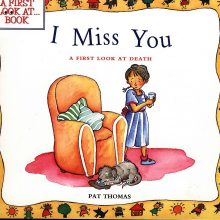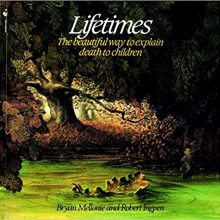Supporting bereaved pre-school age children

Common grief reactions in young children
0-12 Months
Common Grief Reactions
- Babies react to the sense of loss of the person who cares for them.
- They react to smell and the way they are handled.
- They will notice if once smiling faces at feed times become sad faces.
- They may become more unsettled, affecting sleeping and eating patterns.
- They may become more tearful or clingy.
Ways to help
- Maintain familiar and regular routines as much as possible
- Avoid passing the baby round to different people, especially at key times like feeding, bathing and bedtime
- Babies rely on their senses for comfort and security so use familiar smells, sounds, tastes etc.
- Wrapping a baby in an article of clothing belonging to the person who has died might bring comfort through its warmth and smell
1-3 Years
Common Grief Reactions
- Toddlers will notice the absence of the person who has died without understanding what has happened.
- They may repeatedly ask when the person is coming back as they will not understand the finality of death.
- They will pick up the emotions of the adults around them.
- They may express their emotions through changes in behaviour rather than language.
- They may appear more anxious or become more clingy, especially with strangers or at bedtime.
- They may become more aggressive in play or have more temper tantrums.
- They may show some regressive behaviours; behaving as when they were younger when their world felt a safer place.
- They may ask the same questions over and over again.
Ways to help
- Give lots of reassurance, cuddles and understanding
- Give simple explanations to questions, repeating what has been said before
- Maintain familiar routines and boundaries
- Find time to play and relax together
3-5 Years
Common Grief Reactions
- They may struggle to understand the meaning of death, especially its finality, while at the same time using the correct language, giving the impression they understand what has happened.
- They may show signs of missing the person but may hop in and out of their sadness.
- They may ask the same questions repeatedly.
- They may be clingy with a remaining carer and not want to engage with less familiar people.
- They may act out in their play what has happened, especially if the death was the result of a car accident or illness, perhaps by playing doctors and nurses.
- They may show some regressive behaviours, behaving as they did when they were younger.
- They may have outbursts of emotions expressed as anger, shouting or tantrums.
- They may show signs of increased anxiety and worries.
- They may think they were the cause of the person dying – through something they said or did or by being told off before the death.
Ways to help
- Give lots of reassurance, cuddles and understanding
- Give clear simple explanations about what happened and be prepared to repeat the information.
- Encourage family and friends to use the same explanations
- Talk about the person who has died, sharing photographs and stories
- Try to be available, rather than sending the child to be with other relatives or friends.
- Even if you feel unavailable to the child because of your own grief, friends and family could offer support by being with the child in your home where they are still able to see you
- Maintain familiar routines and boundaries
- Involve the child in rituals to say goodbye to the person who died, including any funeral
- Find time to play and relax together
Talking about death with young children
Talking to very young children about death and dying is difficult when your natural instinct might be to protect them from such information. Adults often try to soften the information by using words and phrases like ‘lost’, ‘gone to sleep’, ‘gone’, ‘passed’, ‘become a star’, all of which can add to the young child’s confusion.
Children under five understand their world in concrete terms therefore phrases like these are not helpful to young children and can be very confusing. Instead give clear, honest explanations using clear language and in small pieces like a simple jigsaw puzzle.
When breaking news to children that someone important has died, you may want to:
- begin by saying, “I have something very sad to tell you…”
- find a quiet and comfortable place to break the news, somewhere where you will not be disturbed
- allow unhurried time for the child to respond and ask any questions
- simply tell the child that the person has died. This may be enough at first
- follow the child’s lead for more information – if they ask a question they are probably ready for the answer, so reply to the question but avoid giving too much information or detail
- be prepared to follow this up later with further explanations or repetition of the information you have already given
When explaining what death means, you may want to consider explaining that:
- when someone dies their body stops working
- they don’t feel anything any more like pain, heat or cold
- they don’t need to eat or drink anything
- their body is a bit like an empty shell
- all that made the person so very special, like their smile, the little things they did and said, are what we remember, and these things will stay with us forever
What children need from their caregivers
Physical closeness and connection
Young children need physical contact to feel safe and secure – gentle rocking, stroking, carrying or cuddling.
Age-appropriate responses to on-going questions
It is by repeating questions that young children will gradually understand what has happened.
Play and Fun
Young children need to know that it is ok to have fun and to play and do normal activities. Having fun does not mean that they have forgotten the person who died.
Support to talk about their feelings
Help young children to express difficult feelings in safe ways by talking about how they are feeling. Talk about different feelings using pictures or storybooks.
Memory making
Remembering can be healing so offer opportunities to talk about the person who died. Look at photographs together, tell funny stories, and remember special times as well as the difficult ones. Young children may have few memories of the person who died so building a bigger picture of them will be important – things they did when they were little, where they lived, favourite hobbies, foods etc.
Your belief in their ability to recover and grow
Your hope and faith in their ability to recover may be needed when theirs fails.
Adults who also care for themselves
How parents and carers model this will be crucial. This is why, at SeeSaw, we encourage adults to take care of themselves in order to look after their children. Just as on an aeroplane the instruction in the safety briefing is to put on your own air pressure safety mask before fitting your child’s, so it is following a bereavement. This might be by seeking your own support through grief counselling with a charity such as Cruse.
Seeking help
Over time, most young children cope well with the death of a close family member. However, if you are concerned that your child is feeling overwhelmed by their emotions or that their grief reactions are extreme or persistent, speak to your GP for advice and support.
Resources
Suggested Readings
Always and Forever
by Debi Gliori and Alan Durant
When Fox dies the rest of his family are absolutely distraught. How will Mole, Otter and Hare go on without their beloved friend? But, months later, Squirrel reminds them all of how funny Fox used to be, and they realise that Fox is still there in their hearts and memories.
I miss you: a first look at death
by Pat Thomas
This reassuring picture book explores the difficult issue of death for young children. Children’s feelings and questions about this sensitive subject are looked at in a simple but realistic way. This book helps them to understand their loss and come to terms with it.
Lifetimes
by Bryan Mellonie and Robert Ingpen
A pet . . . a friend . . . or a relative dies, and it must be explained to a child. This sensitive book is a useful tool in explaining to children that death is a part of life and that, eventually, all living things reach the end of their own special lifetimes
Missing Mummy
by Rebecca Cobb
Honest and straightforward, this touching story explores the many emotions a bereaved child may experience, from anger and guilt to sadness and bewilderment. Ultimately, Missing Mommy focuses on the positive—the recognition that the child is not alone but still part of a family that loves and supports him.
The Rabbit Listened
by Cori Doerrfeld
The bear thinks Taylor should get angry, but that’s not quite right either. … With its spare, poignant text and irresistibly sweet illustration, The Rabbit Listened is about how to comfort and heal the people in your life, by taking the time to carefully, lovingly, gently listen.











